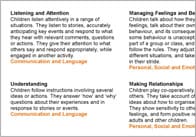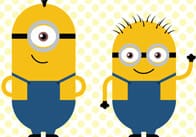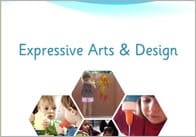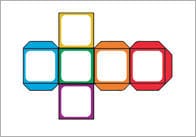Handa’s Hen & Handa’s Surprise Resources
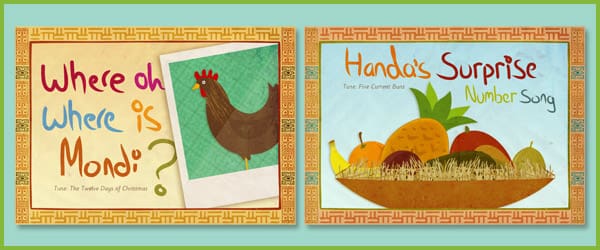
You may have noticed some new additions to the Stories and Songs section. We have added 2 original songs to support Handa’s Surprise and Handa’s Hen stories. The lyrics and artwork are original and are sure to add a new dimension to your children’s learning.
Handa’s Surprise by Eileen Brown is ideal to inspire and extend interest in African animals, a popular Early Years theme. The song, to the tune of Five Current Buns in a Baker’s Shop, brings to life the subtraction and counting back element of the story and helps the children to recall the plot. It has phonic links to the initial sounds of the fruit and uses most of the descriptive words from the story to describe the fruit. The simple rhyming in the song makes it easy to remember and helps with rhyming skills.
The children can act out the song, wearing masks or hats they’ve made themselves. I have found that hats are easier for children to make and to wear as they don’t have to negotiate eye holes!
Making African animal hats
Even the youngest children can successfully, using the skills they have , create unique animal hats. It is so important that children are not over directed in this kind of activity and are offered plenty of choices to show their individuality. They must be allowed to do things their own way without having to hear, ‘No, do it like this!’ The sense of pride and achievement when they wear their own creation is wonderful to see and sometimes it can be the key to sparking a child’s interest in creating something for themselves, an interest which once awakened never leaves them!
Looking at the patterns of different animal skins is a good starting point and finding a way to allow the children to experiment and wallow freely in techniques with rollers, combs, sponge brushes as well as the usual brushes, allows even the youngest children to participate in decorating large sheets of paper with recognisable animal patterns.
Any animal the child is interested in can be made. If they have a selection of different patterned paper to choose from that is a good start but offering plain, different coloured paper will also work with the youngest children because then they only have to focus on adding features. Offer a variety of materials that could represent eyes, ears, whiskers feathers from a selection of collage materials. Being able to stick them wherever they want is important
Having a basic head shape to use helps the youngest children – a paper plate works well. They will enjoy sticking it to their chosen paper and the adult can help the child to cut the shape out, guiding the paper while the child just opens and shuts the scissors in any way they can. They can use offcuts or trim pieces to create ears or trunks etc.
Older children can maybe paint the whole thing themselves or draw and cut out eyes and ears etc from different materials
Attach the head to a strip of card with a stapler (smooth side of the staple toward the hair/ skin always helps! ) and make the strip into a crown which can also be decorated or left plain. Once older children have made hats of their own choosing they may be inspired to make the missing animals from the Handa’s Surprise story.
Making hats, obviously takes time so if you want a quick resource you could use some ready-made animal masks.
Papier mache fruit props
Why not create your own papier mache fruits using this excellent recipe for papier mache pulp. It is lovely, malleable material which dries into a very durable, light resource. Tear up 12 sheets of newspaper into approximately 3cm strips and then squares- this is a good dexterity skill for the children and there is no need for precision or uniformity.
Into an old saucepan ( you can never use it for anything else again!) add the paper and water to cover. Boil it up and stir with an old wooden spoon until the paper disintegrates. When it is cool strain it through a sieve or an old piece of cloth , and squeeze out most but not all of the water. Add about 4 tablespoons of cellulose glue powder and ½ cup of pollyfiller powder. Mix it together until it comes together to create a malleable substance . You may need to add a small amount of water to make it workable.
Mould the shapes you need, allow to dry in the air or in a low oven. Paint to the desired colour. Adding pva to the paint prevents the paint cracking when dry, or paint and then varnish. This is great for making large quantities of fruit or vegetables for a shop role play. These should obviously only be created after seeing , smelling, touching and tasting the real thing but are great as props in a flat basket that can be balanced on Handa’s head.
Other props for the songs could be soft toys or puppets or children could create their own stick puppet animals with a piece of Velcro added for attaching the fruit.
Handa’s Hen
This song is sung to the tune of Twelve Days of Christmas. It is a really challenging song and the children always respond enthusiastically to remembering the numbers of the animals and the order in which they are found. If you have a group of up to 10 children they can each have a stick puppet with the different animals on and raise them up when they are mentioned. Have fun!
This story lends itself so well to small world play that it is worth trawling around to find all the creatures in the story in the required quantities . Use a builder’s tray with maybe huts represented by baskets – I’ve used ones from Ikea. Every early years practitioner will have ways of creating the environment with clever use of textured material etc. I found the early learning centre. Markets, supermarkets or pound shops to be a good source of small animals and insects- often called pocket money toys. You may have to substitute spoonbills with some other bird! Small fluffy Easter chicks are useful too. Older children may be able to make their own using chenille stems, sticks feathers etc.
Popular Teaching Resources
Stay Up To Date
Sign up for our newsletter and we’ll let you know when we create new early years resources.

